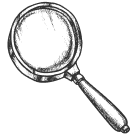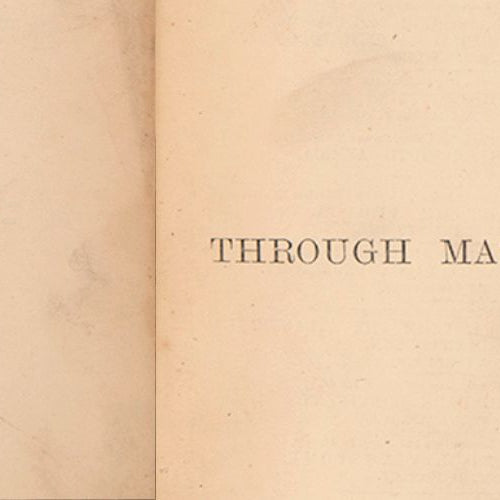
An exceptional, early Victorian natural history manuscript.
Cranborne Chase [Dorset, Hampshire & Wiltshire] 1830s.
Though the author's name is unknown, he appears to have been a gentleman scholar, cleric, or member of the landed gentry living in Cranborne Chase, the region of southeastern England comprising Dorset, Hampshire, and Wiltshire. The manuscript contains an early use of 'extinction' as a biological term, a concept that had only been established by Cuvier in 1796, and his illustrations of animals and birds, while entirely original, are clearly inspired by artists such as Thomas Bewick. Most significantly, he was part of a network of similar men who exchanged knowledge and specimens with each other, and for whom he sometimes prepared specimens. For instance, he writes of the otter that, 'I have seen one shot on the Isis [Thames] near Oxford by Mr. Sandys of Pembroke College'. A common buzzard was 'kindly sent me by Mr. Atty' and he was provided an unusually patterned sparrowhawk egg by 'Mr. James Bryan'. Two members of the Austen family make appearances. In reference to the dartford warbler he reports that 'the one I have was shot by Mr. John Austen of Embury' and a ringed dotterel 'was kindly sent me by Mr. John Austen who shot it near Southampton'. Some of the other locations mentioned include Ashmore, Ashridge, Ashcombe, Melbury, Hemel Hempstead, and Hayling Island.
The present manuscript comprises 50 leaves, with 326 individual watercolours on the rectos and manuscript notes within printed grids on the versos. The illustrations are detailed and accomplished, and the species are easily distinguishable. The artist began each watercolour as a pencil drawing and then finished with delicate inked lines and watercolour fill, and sometimes light washes for the backgrounds. For the zoological images the pencil has been retained as the background foliage, and in some cases erasures and under-drawings are faintly visible. Many of the bird species are accompanied by an illustration of their egg, and the composition of the botanical illustrations was carefully planned, with different species of plants depicted crossing over each other in a naturalistic way, as though the specimens were all standing together.
The accompanying notes are neat and highly legible, and a regular organisational system is maintained throughout, with the scientific family provided (when known) in the left-hand column, then the genus, species, and common name, and then a longer section of notes on the species of animal (plants are only named). The contents of the notes vary depending on the writer's knowledge and experiences, but in general they report on an animal's appearance, habitat, and behaviour, and record of how and where specimens were obtained. For instance:
'The slow-worm is very gentle and inoffensive. Even when roughly handled it rarely attempts to bite. The opinion that it is venomous is a mere vulgar error. When laid hold of it contracts itself so forcibly as to become perfectly stiff, and is then so fragile as to be easily broken in two by a blow, or an attempt to bend it.'
The field vole: 'This little animal is always to be seen in the hay field. It generally has young about the time the grass is cut, and falls an easy prey to dogs and children from seeking refuge in the hay and far from its nest.'
'The spotted flycatcher is the last to arrive of our summer birds. It generally builds in fruit trees trained to the wall, or in hollow posts. The old birds perch on rails and watch for their prey. The eggs are beautifully and variously marked.'
'I have shot the ring ouzel in Hertfordshire, the hen from not having the white round the breast so conspicuous as the cock, is perhaps overlooked as a black bird; but their habits are different and they do not dive into the middle of the bushes, but settle on the top branches.'
'The Ruff is most plentiful in the Fens of Lincolnshire though I believe not so common as formerly. The two specimens I have were sent me by my friend Probert. No two are exactly alike in their plumage.'
What is most remarkable about this manuscript is the broad range of species described. We have handled numerous natural history manuscripts from this period, and they primarily deal with a specific type of animal, for instance birds or insects, or, when more general, stick to the better known species. But this one includes many animals that we have never seen depicted in this format, including bats, newts, the slow-worm, and uncommon rodents such as shrews, voles, and less common rat species. The largest section is on birds, and while the usual game birds, songbirds, and raptors are well-represented, the author has included a huge range of passerines, including less recognisable species such as the stonechat, winchat, wheatear, the dartford, sedge, and willow warblers, redpole, siskin, wryneck, tree creeper, and 'goat sucker' (nightjar). The botanical section is just as diverse, with many species of orchids, nettles, hellbores, brooms, rapes, and even a carnviorous drosera (sun dew), another species we have never encountered in an amateur manuscript.
A beautiful and intellectually engaging manuscript of historical and ecological significance.
Manuscript with watercolours in a purpose-made album with printed grids on the versos of the leaves; oblong quarto (33.5 x 24 cm); 50 leaves, watercolours on the rectos, manuscript tables on the versos of all save number 50, first leaf that presumably had manuscript text on bats lacking, gutters strengthened with paper on which the blanks have been mounted, some spotting and offsetting, and a little darkening to some of the lower corners; original half calf recently rebacked and recornered to style, green grained cloth, very good condition.
Provenance
Delivery
We offer secure and express delivery on all local and international orders of rare books, maps and prints placed through this website.















